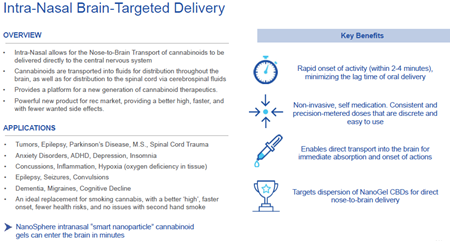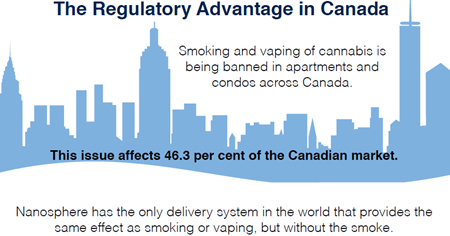
As the cannabis industry matures, both the opportunities and the challenges in this new sector are starting to crystallize. But what is a “challenge” for the cannabis industry as a whole can spell
opportunity for individual companies. Perhaps no niche of the industry illustrates this point better than cannabis delivery technology.
NanoSphere Health Sciences Inc. (
CSE: NSHS,
OTCQB: NSHSF,
Forum) is confident it has developed next-generation technology that supplies the best solution to this challenge to date. But before investors can appreciate the solution, they need to better understand the issues. By now, experienced cannabis investors will be familiar with the primary technical/chemical problem regarding cannabis “delivery”.
 (click to enlarge)
(click to enlarge)
The active ingredients in the cannabis plant are known as cannabinoids, primarily tetrahydrocannabinol (THC) and cannabidiol (CBD). The problem is that these cannabinoid molecules are not water soluble in their natural form. Rather, as oil-based molecules, they are only fat soluble. For newer cannabis investors, further explanation is required.
Water-soluble molecules are metabolized much more rapidly than fat-soluble molecules when ingested. This is because water-soluble molecules bypass initial screening by the liver, one of the body’s principle filters. This “first pass” through the liver not only delays the delivery of these cannabinoids and metabolizes a significant percentage completely (reducing bioavailability), it’s an uneven metabolic process affected by numerous other variables.
Therefore, as fat-soluble molecules, cannabinoids are slow to ingest, much of the medicinal efficacy (or recreational effect) is metabolized, and the efficacy/effect is uneven – because our bodies will metabolize these cannabinoids slightly differently with each use. While this isn’t a safety issue (because cannabis is non-toxic), it is an efficiency and consistency issue. Much of the medicinal or recreational effect is wasted and precise dosing is problematic.
That’s the technical challenge for the cannabis industry. There is also
an emerging regulatory issue with significant repercussions for the cannabis marketplace that relates to this subject. More on this later.
Nanoparticle science: the NanoSphere Advantage
NanoSphere’s solution to this technical challenge is (as its name implies) nanotechnology. By reducing these cannabinoid molecules down to the size of nanoparticles, this “first pass” through the liver is largely avoided.
Bioavailability (absorption) of the cannabinoids increases exponentially and the onset of effect accelerates dramatically.
This is serious science. The Company conducted a “pharmacokinetic” case study on this nanoparticle technology, releasing the results in April 2016.
 (click to enlarge)
(click to enlarge)
There are two take-aways here for investors. First, NanoSphere’s patented nano-encapsulated technology works. Bioavailability is much higher than ordinary oral ingestion. More impressively, the speed to reach maximum medicinal/recreational effect increases dramatically.
The second take-away is that this nano-encapsulation works
better in addressing the solubility challenge than competing delivery systems. In a conference call with Stockhouse Editorial, the Company’s President, Gary Symons framed this for investors.
"On the medical side, we can for the first time provide for a precise dose, and deliver the cannabinoids to the area they are needed to treat a variety of diseases or conditions, which is really the Holy Grail of cannabis science,” said Symons.
“But this is just as important for recreational cannabis, because we can provide a healthier alternative to smoking, vaping and edibles, and we completely eliminate the issue of second-hand smoke for cannabis users.”
It’s a better solution to a big challenge facing the cannabis industry. But the nano-encapsulation itself is only half of the NanoSphere Advantage. Equally important are the modes for delivering these nano-encapsulated cannabinoids. Here NanoSphere has already developed three highly effective options.
Three delivery systems
Nano-encapsulation solves the key technical challenge facing the cannabis industry in terms of providing a high-tech solution for the rapid and efficient delivery of cannabinoids. This also facilitates much more precise/consistent dosing.
However, the cannabinoids delivered by the cannabis plant already serve a multitude of medicinal uses. Equally, recreational consumers of cannabis want flexibility in their mode of consumption. NanoSphere’s three delivery systems provide this necessary flexibility.
 (click to enlarge)
(click to enlarge)
The transdermal delivery system is especially suited to medicinal applications of cannabis that seek localized relief. As a transdermal cream, nano-encapsulated cannabinoids can be delivered rapidly and effectively to the area of application. It’s also ideal for medicinal users requiring THC content but wishing to avoid any psychoactive effects. Gary Symons provided the latest update here.
“We are already seeing incredible results for our transdermal serum, including the treatment of severe, acute pain, which has never been done with cannabinoids until now.”
Both the “intra-oral” and “intra-nasal brain-targeted delivery” provide rapidly accelerated delivery of cannabinoids that is highly suited for either medicinal or recreational use. The intra-nasal system is even faster than intra-oral delivery and is also the most interesting/innovative of the three modes.
 (click to enlarge)
(click to enlarge)
This nano-encapsulated nasal spray penetrates high into the sinus cavity where the nanoparticles come into direct contact with a nerve surface that provides a direct pathway to the brain. This mode of delivery comes closest to duplicating the low-tech mode for the rapid delivery of cannabinoids – smoking cannabis. Medicinal or recreational effects reach a significant level in
less than 90 seconds.
While mimicking the speed of cannabis combustion, this delivery mode offers greater precision in dosing
and avoids the minor respiratory issues associated with smoking cannabis. The intra-oral system is slightly less-rapid than the brain-delivery system, but provides a more controlled, sustained dosage, with a longer ‘half-life’ (duration) of THC in the bloodstream.
Originally “vaping” (a higher-tech form of cannabis combustion) was seen as a solution to address the undesirability of smoking cannabis. However, as the legalization of cannabis has become a reality in Canada – and cannabis usage is expanding significantly – a new, more practical issue has surfaced with respect to cannabinoid delivery.
The “46% market”
Vaping cannabis addresses the health issue associated with smoking cannabis. However, it doesn’t address the
odor issue. Being non-toxic, second-hand cannabis smoke poses no health risks to others, but cannabis is very pungent. In apartment and condo complexes, residents don’t want to be inflicted with the odors from the cannabis usage of other residents.
Already, many of these complexes have established internal
regulations banning cannabis smoking or vaping within the premises. At the provincial level, some Canadian provinces have already legislated restrictions in this area, and several others are actively examining such legislation. This is
a demographic of cannabis users that represents 46.3% of the Canadian population.
 (click to enlarge)
(click to enlarge)
Nano-encapsulation (and NanoSphere’s highly effective delivery modes) provides this 46% demographic within the Canadian population with a reliable, fast, effective option for both medicinal and recreational cannabis use. The Company is busy commercializing this technology and has several strategies in place for capturing revenue streams – both domestically and internationally.
NanoSphere is already on the market in Colorado. Its first product in Canada has been approved for production at Delta 9 Cannabis in Winnipeg, and the Company has signed agreements in Mexico, California, Oregon, Arizona and as of
this week Oklahoma.
Canada is the Company’s initial focus, because of its more advanced regulatory framework and because it is NanoSphere’s base of operations. But NanoSphere is already expanding its global reach. Here the “NanoSphere Advantage” takes a different form.
 (click to enlarge)
(click to enlarge)
In speaking with Stockhouse Editorial, NanoSphere’s President pointed to the strategic/regulatory advantage with this business model. NanoSphere is seeking to penetrate additional markets around the world (primarily) not with cannabis products but with
cannabis technology.
The distinction is that as a
commodity, cannabis commerce is still heavily restricted by the regulatory hurdles arising from cannabis Prohibition. When some new jurisdiction opens up for (first) medicinal cannabis use, attempting to export
cannabis into that market is at best a regulatory labyrinth and at worst a corporate nightmare.
Such legal/regulatory issues have very little impact when it comes to commercializing cannabis delivery technology. This means that NanoSphere has strong early-mover potential in these jurisdictions as it markets its technology solution. Symons clarified further.
“We are not building cannabis grow-ops, and we don’t have to invest tens of millions of dollars of capital into each market. My job as head of our cannabis division is to simply find the best producer in each market, and sign a licensing agreement.
This allows us to grow very quickly, with minimal investment, and very low operational costs, but we also enjoy high margins on constantly recurring revenue.”
The Revenue Model
Investors understand that having a strong product or service to bring to market is only half of the recipe necessary for corporate success. The other half is a strong strategy for developing and building revenue streams – and then executing on that strategy. NanoSphere has been equally intent on developing this side of its business model.
Naturally, the Company is heavily committed to generating licensing/royalty fees from the corporate partners in the cannabis sector wanting to capitalize on the NanoSphere Advantage. But management is also selective, wanting to ensure that its licensing partners have sufficient resources and a sound marketing plan in place to properly commercialize this delivery technology in different jurisdictions.
NanoSphere’s licensing strategy for its cannabis delivery nanotechnology contains both a passive and active component. The difference? In addition to straight licensing agreements for this delivery technology, the Company is involved in its own product development initiatives.
Product development/strategic alliance
NanoSphere is also looking for opportunities to combine its delivery technology with cutting edge R&D of new cannabis formulations targeting specific health/medicinal applications. This is greatly facilitated by NanoSphere’s strategic alliance with
Delta 9 Cannabis (TSX: V.NINE), an established cannabis-producer with its principal base of operations in Manitoba.
President Gary Symons is very bullish on the potential of this branch of operations. Stockhouse will go into greater depth on this in an upcoming feature article.

Ongoing research puts the Company in position to conclude licensing deals and engage in additional marketing initiatives from multiple angles. For production-oriented partners that are developing and marketing their own cannabis products, NanoSphere can license purely its delivery technology. For partners with a strong or total retailing focus, the Company can also market its in-house formulations – enhanced with NanoSphere’s three delivery systems.
An early example of this strategy is the Company’s “Evolve” product line of healthy cannabis products. There are presently three Evolve formulations, all featuring transdermal delivery, the first products to include NanoSphere’s advanced cannabinoid delivery system.
On
December 10, 2018, the Company announced an agreement with Abba Import Export S.A. to supply Abba with Evolve products for Mexico’s emerging cannabis market. The Company has
already received the first order for 60,000 units of its hemp CBD transdermal serum.
Delivering cannabis profits to investors is ultimately all derived from (safely and efficiently) delivering the cannabinoids contained in cannabis to both medicinal and recreational consumers. With its next-generation cannabis technology, NanoSphere Health Sciences is strongly positioned to
deliver.
www.nanospherehealth.com
FULL DISCLOSURE: This is a paid article of Stockhouse Publishing.